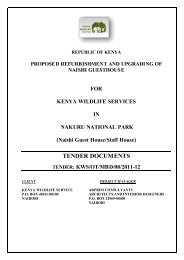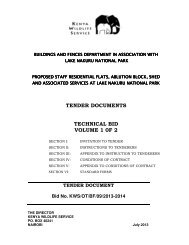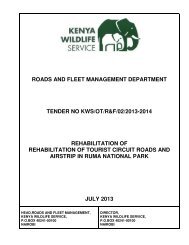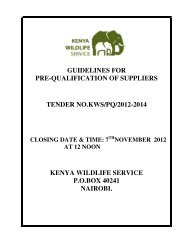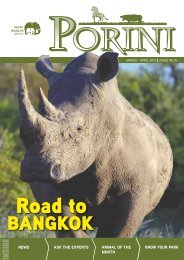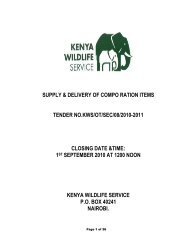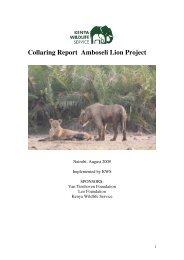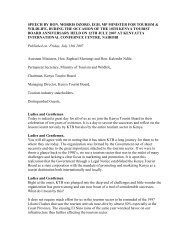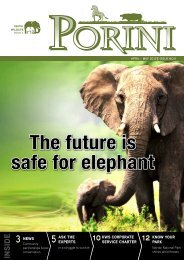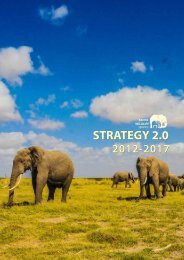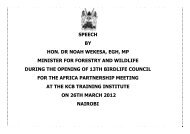Conservation and Management Strategy for the Elephant in Kenya
Conservation and Management Strategy for the Elephant in Kenya
Conservation and Management Strategy for the Elephant in Kenya
You also want an ePaper? Increase the reach of your titles
YUMPU automatically turns print PDFs into web optimized ePapers that Google loves.
xi CONSERVATION AND MANAGEMENT STRATEGY FOR THE ELEPHANT IN KENYA<br />
GLOSSARY<br />
Actions: The activities which need to be implemented to achieve <strong>the</strong> strategy’s objectives <strong>and</strong>, ultimately, its goals<br />
<strong>and</strong> vision.<br />
Actors: Those <strong>in</strong>dividuals responsible <strong>for</strong> actions.<br />
Adult: A mature <strong>in</strong>dividual elephant.<br />
Aggregation: Ga<strong>the</strong>r<strong>in</strong>g, which can be as large as 200–500 elephants. This may <strong>in</strong>clude dozens of family units <strong>and</strong> a number<br />
of mature males; larger aggregations <strong>for</strong>m ma<strong>in</strong>ly dur<strong>in</strong>g <strong>the</strong> ra<strong>in</strong>y season <strong>in</strong> areas where food is plentiful <strong>and</strong> are usually<br />
associated with peak mat<strong>in</strong>g activity. Aggregations are also sometimes seen <strong>in</strong> populations that have been heavily decimated<br />
by poach<strong>in</strong>g or o<strong>the</strong>r disturbances.<br />
Calf: A young elephant, dependant on <strong>the</strong> mo<strong>the</strong>r (until 3–5 years of age).<br />
CITES: Acronym <strong>for</strong> ‘Convention on International Trade <strong>in</strong> Endangered Species of Wild Fauna <strong>and</strong> Flora’, a treaty<br />
signed <strong>in</strong> 1975 by many countries to regulate <strong>the</strong> <strong>in</strong>ternational trade <strong>in</strong> wild animals <strong>and</strong> plants that are <strong>in</strong>cluded <strong>in</strong><br />
its Appendices, <strong>and</strong> <strong>in</strong> products <strong>and</strong> derivatives made <strong>the</strong>reof, <strong>in</strong>clud<strong>in</strong>g elephants <strong>and</strong> elephant products.<br />
Compression Hypo<strong>the</strong>sis: High density of elephants, ow<strong>in</strong>g to restriction of <strong>the</strong>ir range by human settlement.<br />
Cow: An adult female elephant over 15 years old.<br />
Cull<strong>in</strong>g: The kill<strong>in</strong>g of animals that may be regarded as excess <strong>in</strong> a population; a strategic game-management<br />
tool used by some wildlife officials. With elephants, <strong>the</strong> aim is <strong>for</strong> entire family units to be removed at once.<br />
Constra<strong>in</strong>t: Factors which contribute to or compound <strong>the</strong> threats. For example, lack of political will <strong>and</strong> resources<br />
might contribute to dim<strong>in</strong>ished or reduced law en<strong>for</strong>cement, lead<strong>in</strong>g <strong>in</strong> turn to over-exploitation.<br />
Ecosystem: A complete community of liv<strong>in</strong>g organisms <strong>and</strong> <strong>the</strong> non-liv<strong>in</strong>g materials of <strong>the</strong>ir surround<strong>in</strong>gs.<br />
Its components <strong>in</strong>clude plants, animals, micro-organisms, soil, rocks <strong>and</strong> m<strong>in</strong>erals, as well as surround<strong>in</strong>g<br />
water sources <strong>and</strong> <strong>the</strong> local atmosphere.<br />
Elephas maximus: Asian elephant usually divided <strong>in</strong>to 4 subspecies: E.m. borneensis (Borneo elephant),<br />
E. m. <strong>in</strong>dicus (Indian elephant), E. m. maximus (Sri Lankan elephant), E. m. sumatranus (Sumatran elephant).<br />
Goal: A rephras<strong>in</strong>g of <strong>the</strong> Vision <strong>in</strong> operational terms to capture <strong>in</strong> greater detail what needs to be done, <strong>and</strong> where (to save<br />
<strong>the</strong> species). Goals have <strong>the</strong> same long-term time frame <strong>and</strong> wide spatial scale as <strong>the</strong> Vision. Goals use <strong>the</strong> same criteria <strong>for</strong><br />
what it means to save a species as those agreed when develop<strong>in</strong>g <strong>the</strong> Vision (<strong>for</strong> example, striv<strong>in</strong>g to achieve ecologically<br />
function<strong>in</strong>g populations).<br />
Goal Target: Goal targets provide a medium-term (typically 5–10 years) subset of <strong>the</strong> goals. Thus <strong>the</strong>y represent those goals<br />
that can realistically be achieved over <strong>the</strong> lifetime of <strong>the</strong> strategy (<strong>and</strong>/or those steps towards achiev<strong>in</strong>g <strong>the</strong> goals that can<br />
realistically be achieved over <strong>the</strong> lifetime of <strong>the</strong> strategy). Like all targets, goal targets should be SMART.<br />
Group: General term <strong>for</strong> a number of elephants show<strong>in</strong>g coord<strong>in</strong>ated movement <strong>and</strong> behaviour.<br />
Growth Rate: The natural <strong>in</strong>crease <strong>in</strong> <strong>the</strong> size of a population, o<strong>the</strong>rwise referred to as yearly growth rate.



